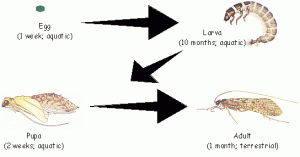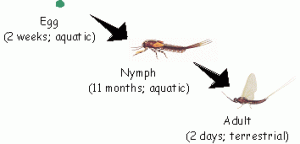4. Macroinvertebrates
Apr 4th, 2014 by Kristin Lewis
Benthic macroinvertebrates are often used as a measure of stream quality.
Benthic macroinvertebrates are relatively large invertebrates that live in or on the bottom of a body of water. The majority of benthic macroinvertebrates are immature insects, but also includes mature crustaceans, molluscs, and annelids.
Benthic macroinvertebrates are used in monitoring stream quality for several reasons:
- They are continuous monitors of environmental quality and integrators of environmental impacts. Macroinvertebrate communities contain many organisms, each with its own preferred environmental conditions and life history. The structure of the community complex – the type and abundance of organisms found – reflects the physical and chemical conditions of the river and its surrounding environment. Changes in these conditions (due to pollution, dams, etc.) are therefore reflected in the community structure. These same changes might be missed by chemical monitoring.
- They are relatively easy to sample. Macroinvertebrates are abundant, relatively immobile, and can be easily collected and identified by trained monitors
- They are a critical part of the aquatic food web. Macroinvertebrates form a vital link in the food chain between aquatic plants, algae, and leaf litter and the upper levels of the food chain, primarily the highly valued game fish species of rivers and streams. Therefore, the macroinvertebrate community reflects the stability and diversity of the aquatic food web.
- They describe a variety of river and stream conditions. The structure of the macroinvertebrate community can tell us the following about conditions in a river or stream
- The overall health of a river ecosystem,
- The impacts on the aquatic ecosystem of various types of pollution, suchas nutrients and sewage
- The impacts on the aquatic ecosystem of specific point and non-point (runoff-related) pollution sources,
- The impacts on the aquatic ecosystem of changes in physical habitat conditions caused by changes in flow, stream-side vegetation, channelization, sedimentation, and other human alterations of the river,
- The effectiveness of efforts to restore physical and chemical in the river.
Many aquatic macroinvertebrates are immature stages of insects.
Many of the invertebrates that you see in the stream are either larval, pupal, or nymph stages of insects. For many species, the majority of the life cycle is spent in the stream, with brief adult stages that immerge from the water and survive only long enough to reproduce.
Some insects like the caddisfly above, go through a process of complete metamorphosis with a transition from egg through larval and pupal stages that do not look like the adult. (Image: Maryland DNR)
Other insects like mayflies and stoneflies go through a process of incomplete metamorphosis. Eggs hatch into a nymph stage that looks similar to the adult but without wings. The insect may go through several nymph stages each time shedding their exoskeleton as they grow. (Image: Maryland DNR)
Other taxa you might see in a stream include:
- Crustaceans like crayfish, sowbugs, and scuds (Phylum Arthropoda).
- Bivalves (clams, mussels) or gastropods (snails) which belong to the Phylum Mollusca.
- Aquatic annelids such oligochete worms and leeches. (Phylum Annelida)
- Planaria or flatworms which belong to Phylum Platyhelminthes.
You will use the following invertebrate key to identify the macro invertebrates that you find at the stream.
Concept Check Questions: (answer on Sakai)
Surveys of benthic macroinvertebrates are often used to survey a stream because:
A. They are easy to sample.
B. They are an important part of a stable stream food web.
C. The types and abundance of macroinvertebrates present in the stream can provide important information about the quality of the stream environment over time.
D. All of the above.
An insect that goes through a series of distinct developmental stages that do not resemble the adult insect is an example of:
A. incomplete metamorphosis
B. complete metamorphosis
You will be asked to identify a number of invertebrates in a matching question using the key above.
This page has the following sub pages.

